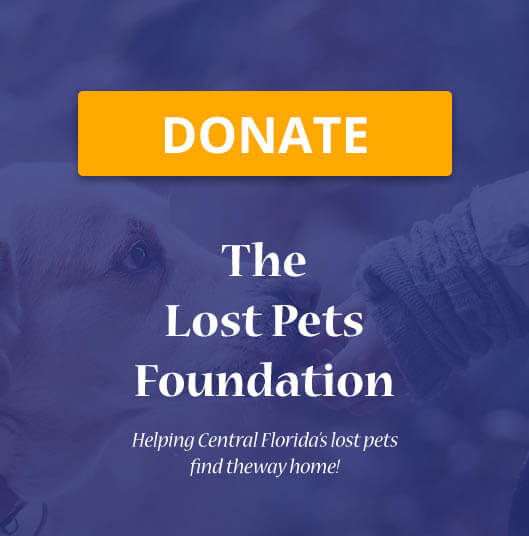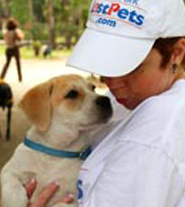Know The City Of Winter Park Ordinances
Chapter 5: Animals
Section II: Animal Services
Sec. 5-29. Definitions.
The following words, terms and phrases, when used in this article, shall have the meanings ascribed to them in this section, except where the context clearly indicates a different meaning:
Abandon shall mean to forsake an animal entirely or to neglect or refuse to provide or perform the legal obligations for care and support of an animal by its owner or keeper. Such abandonment shall constitute the relinquishment of all rights and claims by the owner to such animal, in accordance with F.S. ᄃ 705.19. An animal will not be considered abandoned if the owner or keeper arranges for a person to feed, water, and monitor the animal's condition on a scheduled or regular basis. Intervals between monitoring, watering, and feeding shall not exceed twenty-four (24) hours. An animal shall be considered a stray after thirty (30) calendar days.
Animal shall mean any living dumb creature.
Animal services classification committee shall mean a committee appointed by the board of county commissioners to hear appeals regarding the classification of dogs as dangerous or potentially dangerous.
Animal services officer shall mean any person employed, contracted with or appointed by the county who is authorized to investigate, on public or private property, civil infractions relating to animal control or cruelty and to issue warnings and citations as provided in this article. An animal services officer is not authorized to bear arms or make arrests. The term "animal services officer" also means "code enforcement officer" but only for the purpose of providing confidentiality and exemption from public disclosure of the home addresses and telephone numbers of animal services officers.
At-large shall mean:
(1) With regard to a dog:
(a) A dog off the owner's premises and not under a competent person's control by means of a leash, cord or chain; or
(b) A dog on the owner's property and not under control of a competent person or not confined or restrained by means of a leash, cord or other humane restraining device;
(c) Provided, however, a dog under supervision and engaged in hunting or agricultural or ranching tasks or a competition, trial or show, or designated dog park shall not be considered at large.
(2) A cat, off the owner's premises, which does not display a current rabies vaccination or identification tag.
Certificate shall mean a certificate issued by the county or a licensed veterinarian showing that the animal has been currently vaccinated for rabies.
Certificate of registration shall mean a county dangerous or potentially dangerous dog registration issued pursuant to this article.
Citation shall mean a written notice, in form required by F.S. ᄃ 828.27, and issued by an officer to a person, either in person, by certified mail, or by conspicuous posting upon a dwelling, when the officer has probable cause to believe that the person has committed a civil infraction in violation of this article and that the county court will hear the charge. The citation shall contain:
(1) The date and time of issuance.
(2) The name and address of the person.
(3) The date and time the civil infraction was committed.
(4) The facts constituting probable cause.
(5) The ordinance violated.
(6) The name and authority of the officer.
(7) The procedure for the person to follow in order to pay the civil penalty or to contest the citation or to appear in court.
(8) The applicable civil penalty if the person elects to contest the citation.
(9) The applicable civil penalty if the person elects not to contest the citation.
(10) A conspicuous statement that if the person fails to pay the civil penalty within the time allowed, or fails to appear in court to contest the citation, he/she shall be deemed to have waived his right to contest the citation and that, in such case, judgment may be entered against the person for an amount up to the maximum civil penalty.
(11) A conspicuous statement that a person required to appear in court as ordered does not have the option of paying a fine in lieu of appearing in court.
Clinic shall mean a low-cost spay/neuter facility, operated by the county to perform spay and neuter surgeries, administer rabies shots, provide vaccination tags, and provide emergency care to animals impounded by the animal services division.
Commercial kennel or pet dealer shall mean any premises used for a business requiring an occupational license wherein any person engages in boarding, breeding, buying, letting for hire or training dogs or cats for a fee. County-operated animal services agencies, veterinary clinics, animal hospitals, noncommercial kennels, and societies for the prevention of cruelty to animals (as identified in F.S. ᄃ 828.03) are exempt from this definition.
Competent person shall mean a person of such maturity as to be able to exercise control over an animal.
Control shall mean the regulation of the possession, ownership, care, and custody of animals.
Cruelty shall mean any act of neglect, torture, or torment that causes unjustifiable pain or suffering of an animal, as defined in F.S. ᄃ 828.02.
Dangerous dog shall mean any dog that, according to animal services division records; other animal control or law enforcement authorities; or as attested to by sworn affidavit:
(1) Has aggressively bitten, attacked or endangered or has inflicted severe injury on a human being on public or private property, including the owner's property other than in defense of the owner, or the owner's home, in response to an action of the person injured or attacked;
(2) Has severely injured or killed a domestic animal while off the owner's property;
(3) Has been used primarily for the purpose of dog fighting or is a dog trained for dog fighting; or
(4) Has, when unprovoked, chased or approached a person upon the streets, sidewalks or any public grounds in a menacing fashion or apparent attitude of attack; provided that such actions are attested to in a sworn statement by one (1) or more persons and dutifully investigated by the animal services division.
(5) Dogs used by law enforcement officials for law enforcement work are exempt from dangerous dog classification.
Division manager shall mean the animal services division manager or designee authorized to administer and enforce the provisions of this article.
Domestic animal shall mean any dog, cat, ferret, rabbit, or bird that has been domesticated so as to live and breed in a tame condition.
Every possible effort shall mean attempting to locate the owner of an animal through reasonable means, which may include but is not limited to, the search for an identification tag, tattoo, micro-chip or canvassing of the neighborhood.
Feral cat shall mean an untamed domestic cat living in the wild that has had little or no human contact and is not socialized.
Keeper shall mean any person having temporary (less than thirty (30) calendar days) possession, custody or control of an animal.
Licensed veterinarian shall mean any person who is licensed to engage in the practice of veterinary medicine in the state under the authority of F.S. ch. 474.
Neglect shall mean failure to provide food, water, shelter, adequate ventilation, protection from the elements, or other care generally considered to be normal, usual and accepted for an animal's health and well-being.
Neutered or spayed shall mean rendered permanently incapable of reproduction by surgical alteration, implantation of a device, or other physical means.
Noncommercial kennel shall mean any premises used primarily as the domicile of an animal owner, on which premises said owner breeds purebred or nonpurebred animals for personal recreational use; provided that where said animals are offered for sale, sold or exchanged for profit, said sales shall comprise no more than twenty-five (25) percent of said owner's income.
Nuisance shall mean:
(1) Any domestic animal that disturbs the peace and quiet of a neighboring resident by habitually and repeatedly barking, howling, crying, screaming, whining or making other bothersome noises; or
(2) Any domestic animal that chases automobiles, other vehicles, livestock, or other domestic animals or runs at large; or acts in an aggressive manner; or
(3) Any domestic animal that destroys or damages public or private property or causes a serious annoyance so as to interfere with the reasonable use and enjoyment of public or private property; or
(4) Any domestic animal that urinates or defecates on public or private property without the property owner's consent; or
(5) Any domestic animal which is an unwelcome guest on private or public property.
Officer shall mean any law enforcement officer defined in F.S. ᄃ 943.10, or any animal control officer.
Owner shall mean any person or legal entity possessing, harboring, keeping or having control or custody of an animal on or within their own real property or, if the animal is owned by a person under the age of eighteen (18), that person's parent or guardian. Any person or legal entity who provides food, water, shelter, or care for an animal for thirty (30) calendar days shall be considered to be the owner of said animal.
Potentially dangerous shall mean any dog that, according to animal services division records, other animal control or law enforcement authorities, or as attested to by sworn affidavit, has posed a threat to public safety by:
(1) Causing an injury to a person or domestic animal that is less than a severe injury; or
(2) Without provocation, chasing or menacing a person or domestic animal in an aggressive manner; or
(3) Without provocation, repeatedly acting in a highly aggressive manner within a fenced yard/enclosure and appears to a reasonable person able to jump over or escape.
(4) Dogs used by law enforcement officials for law enforcement work are exempt from potentially dangerous dog classification.
Proper enclosure of a dangerous dog shall mean that while on the owner's property a dangerous dog is securely confined indoors or in a securely enclosed and locked pen or structure suitable to prevent the entry of young children and designed to prevent the animal from escaping. Such pen or structure shall have secure sides, top, and flooring to prevent the dog from escaping over, under or through the structure and shall also provide adequate ventilation and protection from the elements.
Proper enclosure for a potentially dangerous dog shall mean a securely constructed fenced area, in good repair and condition, that the dog is unable to climb over, dig under, or in any way pass or reach through if the dog is to be allowed off leash outside the owner's residence. This area must have secure gates that are to be locked at all times when the animal is present.
Provoked shall mean to tease, molest, torment, abuse, assault, or to instigate behavior in a dog or cat that may lead to the animal attacking or biting a person or another animal.
Restraining device shall mean a chain, cord, or cable, with a minimum length of ten (10) feet, used to confine an animal on an owner's property. This device must provide for humane, unrestrained range of movement for the animal to insure that the animal is not exposed to hazard or injury and shall not prevent the animal from having food, water, shelter, adequate ventilation, protection from the elements or other care generally considered to be normal and usual. This device shall be proportional in size, weigh no more than one-eighth ( 1/8) of the dog or puppy's body weight, and designed for use with the specific breed of animal with an appropriate collar. These devices shall not be used to confine a dog on an owner's property between the hours of 9:00 a.m. and 5:00 p.m., three hundred sixty-five (365) days a year and during times of extreme weather, e.g., hurricanes, below freezing conditions.
Severe injury shall mean any physical injury to a human being or animal that results in broken bones, multiple/repeated bite punctures, disfiguring lacerations or injuries requiring sutures or reconstructive surgery.
Shelter shall mean a secure weather resistant structure which protects an animal from exposure to the elements including but not limited to, rain, cold, wind and heat, that provides for adequate ventilation, and in size is a minimum of six (6) inches higher than the animal's height at full stand with head erect, one and one-half (1 1/2) times the animal's full body length, and sufficient in width to permit the animal to turn around.
Stray shall mean an animal without any known owner or keeper to provide food, water, or shelter for a period of at least thirty (30) calendar days.
Tag shall mean a rabies vaccination tag issued pursuant to this article.
Truck tether system shall mean a system designed to keep a dog securely attached and restrained in the back of a truck, safe and free of hazard and away from the sides of the truck.
Unprovoked shall mean a victim who has conducted himself/herself peacefully and lawfully, and has been bitten, chased in a menacing fashion, or attacked by a dog.
Vaccinated shall mean an animal that has been administered a current one-year or three-year rabies vaccine.
Wholesome exercise shall mean uninhibited movement for a period of time sufficient for the physical well being of an animal, considering the size, age, and breed of that animal.
Wildlife shall mean any nonhuman primate, raccoon, skunk, opossum, fox, reptile, large feline, or any other animal so classified by the Florida Fish and Wildlife Conservation Commission.
Working day shall mean any calendar day excluding Sundays and county holidays.
(Code 1965, ᄃ 3-6; Ord. No. 87-9, ᄃ 6, 3-9-87; Ord. No. 91-8, ᄃ 5, 4-2-91; Ord. No. 95-32, ᄃ 3, 9-26-95; Ord. No. 2002-04, ᄃ 3, 6-4-02; Ord. No. 2005-07, ᄃ 3, 7-12-05)
Cross references: Definitions and rules of construction generally, ᄃ 1-2.
Sec. 5-33. Animals at-large prohibited.
(a) Prohibition of animals at-large.
(1) No domestic animal owner or person having charge, care, custody or control of any domestic animal shall permit, any domestic animal to run at large, upon any public property, or off the premises of the owner.
(2) An officer finding a domestic animal at-large may issue a warning or a citation for such violation. If the owner cannot be identified and located with reasonable effort, such animal may be seized and impounded.
(3) No domestic animal at-large shall be permitted to cause injury, or threat of injury, to any person, or cause property damage.
(4) The owner or keeper of a female dog or cat in heat (estrus) shall confine such dog or cat so as to make it inaccessible to any male dog or cat except for controlled and intentional breeding purposes.
(5) It shall be a violation of this article for the owner or keeper of a dog or cat to tie, chain or otherwise tether such animal in such a manner that it has access to public property or the property of another without the consent of the property owner.
(6) Any domestic animal transported in any open vehicle shall either be within a cage, crate or pen, which is well ventilated and secured within the body of the vehicle, or restrained by one (1) tether, affixed to the center of the vehicle and attached to the collar or harness of the animal to prevent the animal from escaping or causing injury to itself or any person. The tether shall be short enough to prevent the animal's head from reaching the sides or back of the vehicle. Nothing in this subsection shall be deemed to prohibit the transportation of horses, cattle, sheep, poultry or other agricultural livestock in trailers or other vehicles designed and constructed for such purposes.
(b) Seizure of at-large animals; harboring and finder-ownership.
(1) When a domestic animal is at-large a person may seize such animal in a humane manner if the owner of the animal is unknown to the person and the owner of the animal is not identified by any form of identification. Any person, who finds a stray domestic animal, where the owner is unknown, shall relinquish custody to the animal services division or file a found animal report with the animal services division within two (2) calendar days after finding the animal. If the person desires to maintain the seized animal as their own, he/she shall maintain such animal for the time set forth in subsection (2) hereinafter.
(2) Any person who keeps a found domestic animal for thirty (30) consecutive days, and no owner is found, shall be conclusively presumed to be the owner of such animal.
(Ord. No. 95-32, ᄃ 6, 9-26-95; Ord. No. 2005-07, ᄃ 7, 7-12-05)
Editor's note: Prior to its reinstatement by Ord. No. 95-32, section 5-33 had been repealed by ᄃ 9 of Ord. No. 91-8, adopted April 2, 1981. Prior to this repeal, section 5-28 pertained to seizure of animals and derived from Code 1965, ᄃ 3-10, and Ord. No. 87-9, ᄃ 10, adopted Mar. 9, 1987.
Sec. 5-37. Rabies vaccination.
(a) The owner or keeper of a dog, cat, or ferret four (4) months of age or older shall vaccinate such dog, cat, or ferret against rabies through a licensed veterinarian. Evidence of rabies vaccination shall consist of a certificate signed by the licensed veterinarian administering the vaccination and identifying the owner and the address of the dog, cat, or ferret and containing such other information as required by state law.
(b) A rabies vaccination is excused only if a dog, cat, or ferret is less than four (4) months of age, or if a licensed veterinarian certifies in writing that rabies vaccination would be injurious to the health of a dog, cat, or ferret. In the latter case, such dog, cat, or ferret shall be confined in an enclosed building or a kennel at all times until a licensed veterinarian can safely vaccinate the dog, cat, or ferret.
(c) The county rabies control program shall be carried out pursuant to F.A.C. ch. 64D-3 and the following provisions:
(1) When a dog or cat has bitten or is believed to have bitten a human being or another animal, or is suspected of carrying rabies, the dog or cat shall be quarantined for rabies observation for a reasonable period of time, as determined by the division manager, but in no case less than ten (10) calendar days. The owner/keeper of such dog or cat shall relinquish possession of the dog or cat for the purpose of quarantine. Refusal to surrender any animal believed to have inflicted a bite on a person upon lawful demand shall be in violation of this article. At the discretion of the division manager, any such dog or cat without a current rabies vaccination may be kept in quarantine at the owner's expense in a county shelter or at an approved holding facility of a local veterinarian or an approved boarding kennel.
(2) The state department of health and rehabilitative services county public health unit director/administrator or the state health officer may make an exception and approve confinement of a dog or cat having a current rabies vaccination administered by a licensed veterinarian at the owner's home or at another acceptable location. If the division manager determines, at any time during the quarantine period, that the owner/keeper of the dog or cat has failed to sufficiently confine the dog or cat, the owner shall relinquish possession of the dog or cat to the animal services division. The dog or cat will then be confined in the custody of the animal services division or at an approved holding facility of a local veterinarian for the remainder of the quarantine period at the owner's expense.
(3) Dogs and cats or other animals under quarantine shall not be released or removed from the place of quarantine unless permission is obtained from the county health unit director or the state department of health and rehabilitative services county public health unit director/administrator or the state health officer.
(4) Bites of guinea pigs, hamsters, ferrets, lagomorphs (rabbits and hares), livestock, squirrels, gerbils, chipmunks, rats, mice and other rodents shall be evaluated on an individual basis at the discretion of the state department of health and rehabilitative services county public health unit director for a determination as to the need for laboratory examination.
(5) Any free-roaming wild mammal that has bitten or exposed a human to rabies shall be disposed of immediately in a manner that the head of the animal can be submitted to one (1) of the laboratories of the state department of health and rehabilitative services for examination for rabies. When a free-roaming wild mammal which is on a list of endangered animal species is involved, the Florida Fish and Wildlife Conservation Commission shall be notified and given the opportunity to obtain the specimen and other relevant information.
(6) Any dog or cat with a current rabies vaccination that is bitten or exposed by a known rabid animal shall be revaccinated immediately by a licensed veterinarian and quarantined for ninety (90) calendar days. The state health director or his designee may permit such animal to be quarantined at home, the animal services division, or another approved facility. Such animal shall be on a leash when taken outdoors.
(7) Any dog or cat without a current rabies vaccination that is bitten by or exposed to a known rabid animal shall be disposed of or, if the owner so desires, placed under rabies quarantine for six (6) months at the owner's expense in a place approved by the state department of health and rehabilitative services county public health unit director/administrator or the state health officer. Such animals shall be given a rabies vaccination upon entering quarantine and shall be revaccinated one (1) month prior to release from quarantine.
(8) Any animal held under quarantine must be claimed by the owner within three (3) working days following the last day of quarantine unless prior arrangements have been made or the animal shall be considered abandoned and disposed of as the animal services division deems appropriate.
(9) The owner of any dog or cat held under quarantine must provide proof of vaccination against rabies or have the dog or cat vaccinated against rabies before the dog or cat will be released from quarantine. The owner's failure to have the dog or cat vaccinated against rabies shall be a violation of this article.
(Code 1965, ᄃ 3-14; Ord. No. 87-9, ᄃ 14, 3-9-87; Ord. No. 91-8, ᄃ 13, 4-2-91; Ord. No. 95-32, ᄃ 10, 9-26-95; Ord. No. 2002-04, ᄃ 6, 6-4-02; Ord. No. 2005-07, ᄃ 11, 7-12-05)
Sec. 5-38. Certificates and tags.
(a) Rabies certificates and tags issued by licensed veterinarians and veterinary clinics will be recognized as appropriate identification for dogs, cats and ferrets in Orange County.

Cofounder and Sponsor

Shelley Heistand
Premier Sotheby’s International Realty
407-718-9222
Cofounder Executive Director

Judy Charuhas
Contact Judy here

